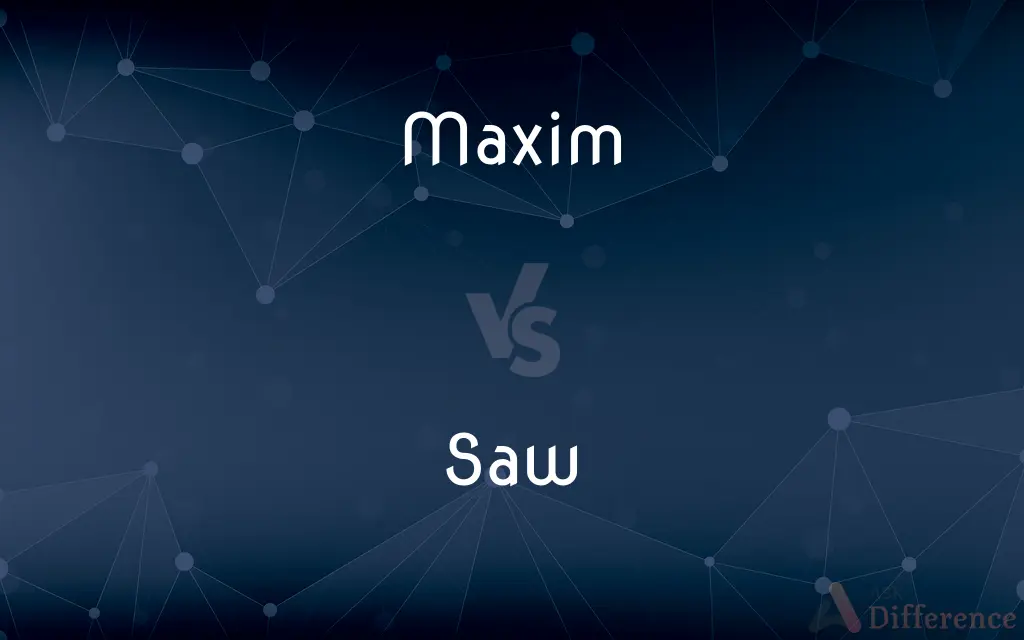Maxim vs. Saw — What's the Difference?
By Tayyaba Rehman & Fiza Rafique — Updated on April 2, 2024
A maxim is a concise statement expressing a general truth or rule of conduct, focusing on guidance and wisdom. A saw, however, is a traditional saying or proverb, often metaphorical, emphasizing folklore and practical advice.

Difference Between Maxim and Saw
Table of Contents
ADVERTISEMENT
Key Differences
Maxims serve as guidelines or principles for behavior, often reflecting moral or ethical standards. They are concise and generalizable, offering wisdom or insight into how one should act or view the world. Maxims are used in formal contexts and philosophical discussions, attributed to their structured and often profound nature. On the other hand, a saw is a type of old saying or proverb, characterized by its common use and folk origin. Saws are typically colloquial, embodying practical wisdom or truths derived from everyday experiences. They are passed down through generations, reflecting the culture and societal norms of their origins.
While maxims often aspire to universal applicability, providing timeless guidance across various situations, saws are rooted in specific cultural or historical contexts. The latter may contain wisdom that is applicable to a wide audience but is usually framed within the conventions and common sense of a particular time and place. This distinction highlights the broader, more philosophical appeal of maxims versus the localized, practical advice found in saws.
Maxims are usually formulated in a deliberate manner, often by philosophers, leaders, or thinkers, aiming to encapsulate complex ideas in a digestible format. Saws, however, emerge from communal wisdom and shared experiences, often lacking a single attributable author. They are more likely to use metaphorical language and imagery, making them memorable and easily understood by people from various walks of life.
Despite their differences, both maxims and saws play significant roles in cultural and individual guidance. Maxims appeal to the intellect and moral reasoning, asking for reflection and internalization. Saws, by contrast, connect with everyday life, offering advice that is immediately applicable and grounded in common sense.
The choice between using a maxim and a saw depends on the context and the intended message. Maxims are suited for formal advice and discussions requiring a high level of abstraction, while saws are best for conveying practical wisdom in a more accessible and relatable manner.
ADVERTISEMENT
Comparison Chart
Definition
A concise statement expressing a general truth or rule of conduct.
A traditional saying or proverb, often metaphorical.
Origin
Often attributed to philosophical, moral, or intellectual inquiry.
Emerges from folk wisdom and communal experiences.
Purpose
To provide guidance or principles for behavior.
To offer practical wisdom or advice based on common sense.
Language
Formal and structured.
Colloquial and metaphorical.
Universality
Aims for universal applicability.
Rooted in specific cultural or historical contexts.
Compare with Definitions
Maxim
General Truth.
Actions speak louder than words emphasizes the importance of actions over promises.
Saw
Practical Advice.
A stitch in time saves nine advises prompt action to prevent further trouble.
Maxim
Rule of Conduct.
Treat others as you would like to be treated guides interpersonal behavior.
Saw
Traditional Saying.
Don't count your chickens before they hatch warns against premature expectations.
Maxim
Moral Guidance.
Honesty is the best policy underscores the value of truthfulness.
Saw
Folk Wisdom.
An apple a day keeps the doctor away promotes daily habits for health.
Maxim
Philosophical Insight.
Know thyself encourages self-awareness and understanding.
Saw
Metaphorical Guidance.
You can't make an omelet without breaking eggs suggests that sacrifices are necessary for progress.
Maxim
Behavioral Guideline.
When in Rome, do as the Romans do suggests adapting to local customs.
Saw
Colloquial Proverb.
Every cloud has a silver lining encourages looking for the positive in bad situations.
Maxim
A short, pithy statement expressing a general truth or rule of conduct
The maxim that actions speak louder than words
Saw
A saw is a tool consisting of a tough blade, wire, or chain with a hard toothed edge. It is used to cut through material, very often wood though sometimes metal or stone.
Maxim
A succinct formulation of a fundamental principle, general truth, or rule of conduct.
Saw
Any of various tools, either hand-operated or power-driven, having a thin metal blade or disk with a sharp, usually toothed edge, used for cutting wood, metal, or other hard materials.
Maxim
A self-evident axiom or premise; a pithy expression of a general principle or rule.
Saw
A familiar saying, especially one that has become trite through repetition.
Maxim
A precept; a succinct statement or observation of a rule of conduct or moral teaching.
Saw
To cut or divide with a saw.
Maxim
Alternative case form of Maxim
Saw
To produce or shape with a saw
Sawed a hole in the board.
Maxim
An established principle or proposition; a condensed proposition of important practical truth; an axiom of practical wisdom; an adage; a proverb; an aphorism.
'T is their maxim, Love is love's reward.
Saw
To make back-and-forth motions through or on
A speaker who saws the air with his arms.
Maxim
The longest note formerly used, equal to two longs, or four breves; a large.
Saw
To use a saw
Sawing along the chalk line.
Maxim
A saying that widely accepted on its own merits
Saw
To undergo cutting with a saw
Pine wood saws easily.
Maxim
English inventor (born in the United States) who invented the Maxim gun that was used in World War I (1840-1916)
Saw
Past tense of see1.
Saw
A tool with a toothed blade used for cutting hard substances, in particular wood or metal.
Saw
Such a tool with an abrasive coating instead of teeth.
Saw
A musical saw.
Saw
A sawtooth wave.
Saw
(obsolete) Something spoken; speech, discourse.
Saw
(archaic) A saying or proverb.
Old saw
Saw
(obsolete) Opinion, idea, belief.
Saw
(obsolete) Proposal, suggestion; possibility.
Saw
(obsolete) Dictate; command; decree.
Saw
(transitive) To cut (something) with a saw.
Saw
(intransitive) To make a motion back and forth similar to cutting something with a saw.
Saw
(intransitive) To be cut with a saw.
The timber saws smoothly.
Saw
(transitive) To form or produce (something) by cutting with a saw.
To saw boards or planks (i.e. to saw logs or timber into boards or planks)
To saw shingles
To saw out a panel
Saw
Something said; speech; discourse.
Saw
A saying; a proverb; a maxim.
His champions are the prophets and apostles,His weapons holy saws of sacred writ.
Saw
Dictate; command; decree.
[Love] rules the creatures by his powerful saw.
Saw
An instrument for cutting or dividing substances, as wood, iron, etc., consisting of a thin blade, or plate, of steel, with a series of sharp teeth on the edge, which remove successive portions of the material by cutting and tearing.
Saw
To cut with a saw; to separate with a saw; as, to saw timber or marble.
Saw
To form by cutting with a saw; as, to saw boards or planks, that is, to saw logs or timber into boards or planks; to saw shingles; to saw out a panel.
Saw
Also used figuratively; as, to saw the air.
Saw
To use a saw; to practice sawing; as, a man saws well.
Saw
To cut, as a saw; as, the saw or mill saws fast.
Saw
To be cut with a saw; as, the timber saws smoothly.
Saw
A condensed but memorable saying embodying some important fact of experience that is taken as true by many people
Saw
Hand tool having a toothed blade for cutting
Saw
A power tool for cutting wood
Saw
Cut with a saw;
Saw wood for the fireplace
Common Curiosities
How do saws reflect their cultural origins?
Saws incorporate language, imagery, and wisdom that resonate with the experiences and values of the culture from which they originate.
How do saws convey practical wisdom?
Through metaphorical language and imagery, saws distill complex life lessons into simple, memorable phrases based on common sense and shared experiences.
Why are maxims important in literature?
Maxims provide insights into the themes, moral dilemmas, and character motivations in literature, serving as concise reflections of broader truths.
What is the main purpose of a maxim?
To articulate a general truth, principle, or rule of conduct that guides behavior and thinking.
How do individuals use maxims and saws in conversation?
They use them to offer advice, make a point, or connect with shared cultural wisdom in a concise and impactful manner.
Can a maxim become a saw?
While their origins differ, a widely accepted and used maxim can enter common parlance and be considered a saw, especially if it gains metaphorical or colloquial expression.
Can the use of maxims and saws differ across cultures?
Yes, what constitutes a maxim or a saw can vary significantly across cultures, reflecting differing values, experiences, and historical contexts.
What makes a saw memorable?
Its use of metaphor, rhyme, and rhythm, along with its grounding in everyday experiences, makes a saw easy to remember and repeat.
What role do maxims play in education?
They can serve as tools for teaching critical thinking, moral reasoning, and the importance of wisdom and virtue.
Are maxims always true?
Maxims are intended to be universally applicable, but their relevance and truth can vary depending on individual perspectives and situations.
Is there a formal study of maxims and saws?
Yes, the study of proverbs (paremiology) includes the examination of saws, while philosophy and ethics often explore maxims.
How can understanding maxims and saws benefit personal development?
They can provide ethical guidance, practical advice, and insights into human nature and society, aiding in personal growth and decision-making.
Are there any modern maxims or saws being created today?
Yes, as society and technology evolve, new maxims and saws emerge to reflect contemporary challenges, wisdom, and values.
Do maxims and saws change over time?
While their core messages often remain stable, the language and examples used can evolve to reflect changing societal norms and realities.
How do saws contribute to cultural identity?
They encapsulate and transmit the values, humor, and wisdom of a culture, strengthening a sense of belonging and identity.
Share Your Discovery

Previous Comparison
Deconstruction vs. Reconstruction
Next Comparison
Instigator vs. TroublemakerAuthor Spotlight
Written by
Tayyaba RehmanTayyaba Rehman is a distinguished writer, currently serving as a primary contributor to askdifference.com. As a researcher in semantics and etymology, Tayyaba's passion for the complexity of languages and their distinctions has found a perfect home on the platform. Tayyaba delves into the intricacies of language, distinguishing between commonly confused words and phrases, thereby providing clarity for readers worldwide.
Co-written by
Fiza RafiqueFiza Rafique is a skilled content writer at AskDifference.com, where she meticulously refines and enhances written pieces. Drawing from her vast editorial expertise, Fiza ensures clarity, accuracy, and precision in every article. Passionate about language, she continually seeks to elevate the quality of content for readers worldwide.















































